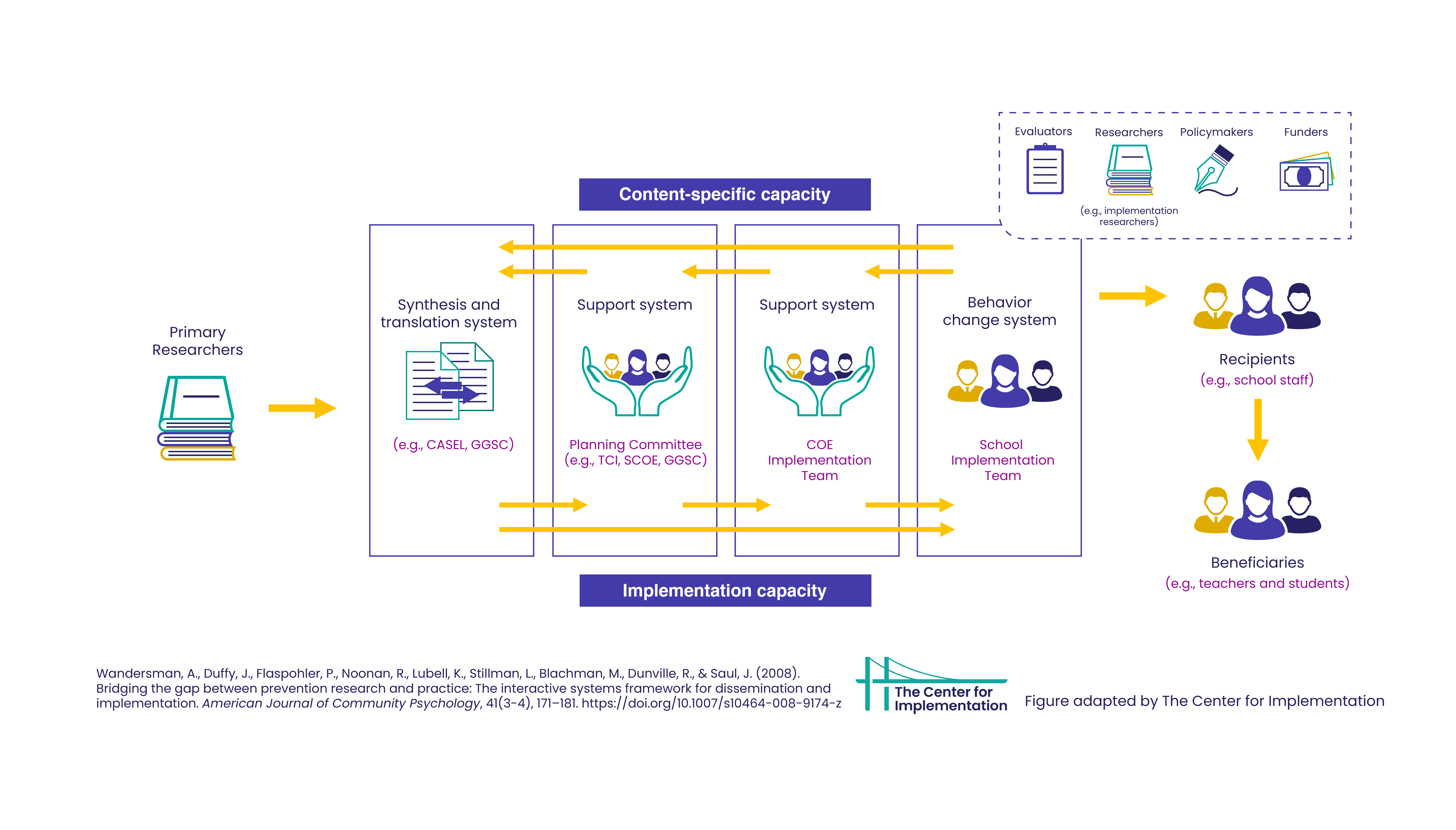
Module 1
What is an implementation support system?
Key Points
Click on each bullet point to read more.
• Clarifying roles in implementation
In all implementation projects, what we aim for is some type of change. The individuals or group of individuals who benefit from this change are referred to as beneficiaries. In the context of CalHope, teachers or students may occupy the beneficiary role.
In order to make change happen, implementation requires that people do something differently. The individuals whose behaviour is required to change through implementation are referred to as recipients. Teachers are an example of recipients within SEL implementation.
Behaviour change does not spontaneously happen. It requires a system of people to adopt certain roles, and for people in those roles to interact with one another. In schools, SEL teams plan for, and may deliver, implementation of SEL practices, programs and/or approaches. This is what we call the behavior change role – essentially, the people occupying this role are the people who are ensuring that staff and students adopt SEL within schools.
There are also people working in the system who compile the evidence for what is being implemented. These people occupy what we call the synthesis and translation role. For example, CASEL has brought together evidence behind SEL and has synthesized that evidence and developed a repository of programs, approaches, and practices for SEL.
A final core role within implementation, and one that is often overlooked, is the support role. People and organizations who play a support role pull from what those occupying a synthesis and translation role have done and support people in the delivery role to put evidence into practice in a way that addresses their needs. In the context of CalHope, COEs can occupy a support role.
Action: You can use implementation roles to start mapping out what your implementation system will look like. This will enable you to understand where your strengths are and what areas require further consideration and planning.

• Ways COEs can support implementation
You will be providing schools and LEAs with implementation supports. In practice, what this means is that you will be providing them with tools, training, coaching, and fidelity assessments. The provision of these implementation supports falls into two categories. First, you might need to provide SEL-specific supports; in other words, SEL-specific tools, training, coaching, and fidelity. However, in order to make sustainable change happen, you will also need to support people in how to effectively implement. This means that you will also need to provide implementation-specific tools, training, coaching, and fidelity.
Action: You can use these categories to guide you in thinking about what your supports might look like.
• Topics that might be covered when providing support
You can provide support in multiple ways, but what you provide support with is grounded in the core activities of implementation teams, who oversee implementation in schools. Before outlining the types of support that you can provide to implementation teams within schools (and possibly within LEAs), an overview of some of the common activities implementation teams take on to make change happen is provided below.
Implementation teams make change happen by supporting these core activities:
- Establishing buy-in
- Understanding needs and gaps
- Defining goals and outcomes
- Defining the changes
- Identifying barriers that need to be addressed to support practice change or improvement
- Identifying strategies that will support practice changes or improvements
- Assessing readiness for change
- Planning for implementation adaptations, and sustainability
- Monitoring and tracking progress
- Evaluating
When providing support to an implementation team, your focus is on building the capacity of individual members of the team to work through the practical aspects of implementation. You may:
- Identify gaps in team knowledge and skills and identify resources to strengthen team capacity
- Offer strategies and advice to overcome challenges
- Motivate and inspire people invested in or impacted by the change to action
- Offer tools, training, and fidelity assessments
- Build the capacity of the team to apply best practices and approaches from quality improvement, implementation science and other related fields.
Action: Learning about the different implementation pathways can help you hone in on what processes you might to support in-school implementation teams through.
• How ready are you to provide support?
The concept of readiness, and assessing readiness, is not just relevant at the school- and LEA-levels. You will need to provide schools and, in some cases, LEAs with both SEL-specific and implementation-specific supports. Therefore, it is also important to reflect on your own readiness to adopt the role of implementation support. Are you psychologically ready? Are you structurally ready? What would make you feel more ready?
Action: It is good practice to reflect and have discussions internally about where you feel your strengths and weaknesses are. Within CalHope, there are several resources you can leverage to increase your SEL and implementation support capacities, so it is a good idea to dedicate time to exploring these.
Videos
Implementation Roles
In this video, we describe the major roles that people occupy when implementing an initiative, and where the implementation support role fits.
How can COEs support SEL implementation?
This video describes the components of an implementation support process, and can help COEs decide which components they can select to support school SEL implementation.
Implementation Pathways
Here, we discuss the different pathways you can take, and the multiple activities that encompass, SEL implementation. Understanding these pathways can help guide you on how you can support schools.
Readiness
This video can be used as a turnkey resource by COEs to explain to schools why readiness is important to SEL implementation.
Tools & Resources
Activity for Module 1 is covered in Module 2 and is designed to help you build a model or process for what SEL implementation support will look like in your county – who will be providing support, what their support goals are, and what the support strategies will be.
Please, see Module 2 for Activity Guide.
Spotlight - Solano County Office of Education
In this video, Solano County Office of Education describe the components of their support process for SEL implementation.
